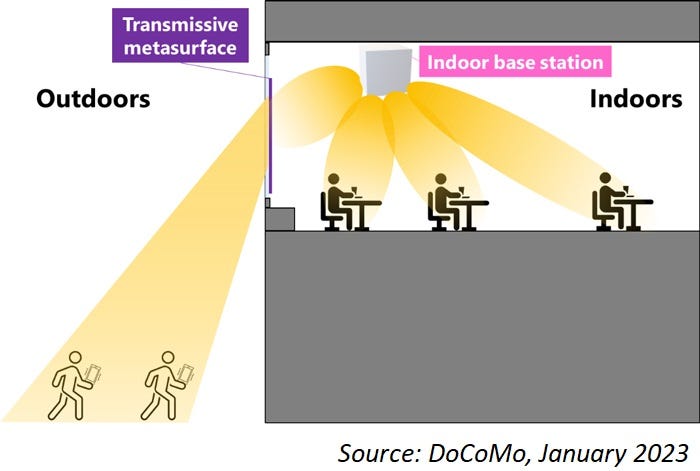DoCoMo trials give a window into possible 6G techDoCoMo trials give a window into possible 6G tech
Japanese telco DoCoMo wants windows to be a help not a hindrance to signal propagation.
January 30, 2023

Japanese telco DoCoMo wants windows to be a help not a hindrance to signal propagation.
In what it claims is a world first, the operator used a ‘metasurface’ attached to a window that was able to redirect a signal coming from an indoor base station to the foot of the building outside.
Metasurfaces, like metamaterials, consist of intricate, nanoscale structures laid out in a specific pattern in order to manipulate the path that radiation – whether that be light or electromagnetic – takes through it. This is potentially useful when it comes to improving the performance of super high frequency spectrum, which is limited by high attenuation and requires technologies like beamforming to direct signals towards devices.
And with the telecoms industry beginning to discuss the use of sub-TeraHertz spectrum in bands above 100 GHz for 6G services, signal propagation is set to become an even hotter topic than it was during the development of 5G.
“Radio waves in the high-frequency band have difficulty reaching places that are not in the line of sight of the transmitting base station installed on the rooftop of buildings, making it difficult to create reception areas at the foot of buildings,” said DoCoMo, in a statement on Monday. “One of the solutions is to install antennas on a neighbouring structural object, but there are cases where such installation is not possible due to landscape and other issues. This trial was conducted in order to expand the area of coverage around the foot of a building.”
In the trial, DoCoMo used a metasurface designed specifically to redirect 28-GHz spectrum while not affecting the path of LTE and other sub-6-GHz frequencies – or spoiling the view from the window for that matter.
“We confirmed that the throughput performance in the foot area was greatly improved by bending the millimetre waves with the transmissive metasurfaces,” said DoCoMo.
DoCoMo is also experimenting with new types of windows altogether.
In a separate announcement, it said it has been working with US glazing company YKK AP to measure the radio-wave penetration characteristics of windows made from a material called aerogel. The ‘gel’ part of the name is slightly confusing, because it is actually a solid material that happens to be made from a gel. It weighs very little, lets in lots of light, but is highly insulating, making it ideal for things like windows.
“High-performance materials, multilayered window glass and Low-E glass are being used more widely to improve the insulation of homes and offices for energy efficiency. As a consequence, however, it is becoming more difficult for high-frequency radio waves used by cellphones and other applications to reach indoor spaces,” said DoCoMo. “In response, DoCoMo and YKK AP are developing windows that allow radio waves to pass through easily while still maintaining high-performance thermal insulation.”
The two companies have worked up a prototype that will enable them to test which different materials, shapes and window structures are best at allowing mobile signals to pass through. They reckon that one day it will be possible to install aerogel windows on new and existing homes and offices.
“Going forward, DoCoMo will continue to work toward 5G Evolution and 6G by researching and developing technologies including windows easily penetrated by high-frequency millimetre and TeraHertz radio waves for high-quality indoor connectivity,” the telco said.

Get the latest news straight to your inbox. Register for the Telecoms.com newsletter here.
About the Author
You May Also Like










.png?width=300&auto=webp&quality=80&disable=upscale)


_1.jpg?width=300&auto=webp&quality=80&disable=upscale)